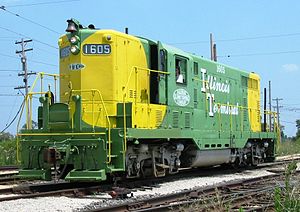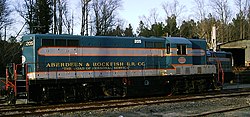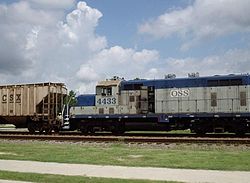This article includes a list of general references, but it lacks sufficient corresponding inline citations. (September 2012) |
| EMD GP7 | |||||||||||||||||||||||||||||||||||||||||||||||||||||
|---|---|---|---|---|---|---|---|---|---|---|---|---|---|---|---|---|---|---|---|---|---|---|---|---|---|---|---|---|---|---|---|---|---|---|---|---|---|---|---|---|---|---|---|---|---|---|---|---|---|---|---|---|---|
 ITC 1605, at the Illinois Railway Museum | |||||||||||||||||||||||||||||||||||||||||||||||||||||
| |||||||||||||||||||||||||||||||||||||||||||||||||||||
| |||||||||||||||||||||||||||||||||||||||||||||||||||||
| |||||||||||||||||||||||||||||||||||||||||||||||||||||
| |||||||||||||||||||||||||||||||||||||||||||||||||||||




The EMD GP7 is a four-axle (B-B) diesel-electric locomotive built by General Motors Electro-Motive Division and General Motors Diesel between October 1949 and May 1954.[2]
The GP7 was the first EMD road locomotive to use a hood unit design instead of a car-body design. This proved to be more efficient than the car body design as the hood unit cost less to build, was cheaper and easier to maintain, and had much better front and rear visibility for switching.[5] Power was provided by an EMD 567B 16-cylinder engine which generated 1,500 horsepower (1,119 kW).[6] The GP7 was offered both with and without control cabs, and those built without control cabs were called a GP7B. Five GP7B's were built between March and April 1953.[2]
Of the 2,734 GP7's built, 2,620 were for American railroads (including 5 GP7B units built for the Atchison, Topeka and Santa Fe Railway), 112 were built for Canadian railroads, and 2 were built for Mexican railroads.
This was the first model in EMD's GP (General Purpose) series of locomotives. Concurrently, EMD offered a six-axle (C-C) SD (Special Duty) locomotive, the SD7.[5] The GP7 was replaced by the GP9 model in GM-EMD's GP sequence.
- ^ a b c d e f g h Schrenk & Frey (1988) p.291
- ^ a b c Pinkepank, Jerry A. (1973) pp. 53
- ^ IC Railroad 1969 diesel diagrams, pp.46–47
- ^ Cite error: The named reference
NPdia557was invoked but never defined (see the help page). - ^ a b Schafer, Mike (1998). Vintage diesel locomotives. Osceola, WI: Motorbooks International. p. 37. ISBN 0-7603-0507-2. OCLC 38738930.
- ^ The History of EMD Diesel Engines